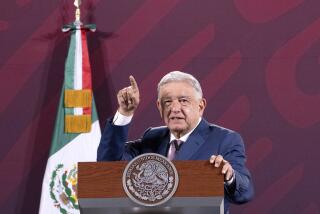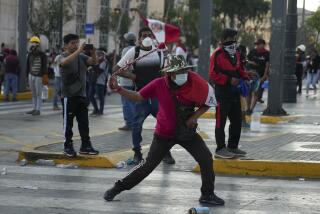Mexico’s Zapatistas Make Move Toward Peace
- Share via
SAN CRISTOBAL DE LAS CASAS, Mexico — After a two-year stalemate that was scarred by a massacre, Zapatista guerrilla commanders met with a congressional peace commission Friday night in Chiapas state to explore chances for renewing peace talks between the rebels and the government.
However, almost as soon as the meeting began, the Zapatistas emerged and issued a scathing attack of the 18-member congressional team for failing to provide decent food, accommodations and security for the 29 rebel commanders who had come out of their jungle and mountain strongholds for the gathering.
The congressional Commission for Harmony and Pacification, known by its Spanish acronym, COCOPA, had said it would ensure the Zapatistas’ safety but was not responsible for their personal needs.
Rebel Comandante Tacho said the legislators’ treatment of the rebel leaders was a case of racism toward indigenous Mexicans and a return to the days of the Spanish conquest in the 16th century.
The rebel outburst underscored the mistrust between the two sides just as the first face-to-face meeting between the leftist rebels and any governmental authority since January 1997 was getting underway. It was unclear whether the dispute will derail the negotiations, which are scheduled to conclude with a second session Sunday night, or whether a solution will be found.
That the meeting came about at all raised hopes for a resumption of peace talks and an end to a conflict over Indian rights that began with the surprise Zapatista uprising in this colonial highland town and other centers across this southern Mexican state on Jan. 1, 1994.
More than 145 people were killed in the initial fighting, and at least that many have been killed since then in periodic skirmishes with police and tit-for-tat clashes--including a massacre of 45 pro-Zapatista peasants last December by pro-government paramilitary groups in the village of Acteal.
Ahead of the negotiations, both sides expressed guarded confidence that progress could be achieved in the talks.
“We want to build permanent bridges for dialogue that don’t exist now,” said Jose Luis Lopez, a COCOPA member and legislator from the Labor Party. “This is a first step toward a direct meeting between the government and the Zapatistas, so it is extremely important.”
The congressional commission is not empowered to negotiate with the rebels. That power is reserved for the executive branch. Rather, the commission’s job is to facilitate progress in the dispute.
The Zapatistas scheduled the talks with COCOPA to coincide with the movement’s “Encounter With Civil Society,” a festive three-day gathering of pro-rebel civic organizations from Mexico and abroad. The 2,000 or so delegates to the gathering helped provide a civilian security cordon around the Zapatista leaders. The government had agreed to ensure the safe passage of the rebel commanders from their hide-outs.
At the inaugural session of the gathering, a rebel leader known as Comandante David appeared to be referring to the meeting with the commission members later in the day as he described the rebels’ objectives.
“We want an encounter that is a search for peace and an analysis of the national situation, so we can start to walk the road toward a more free, more fair and more democratic country,” said Comandante David, wearing the trademark Zapatista black ski mask and the tasseled black hat of the Tzotzil Indians of the Chiapas highlands.
“In Mexico and around the world, members of civil society have raised voices that speak to us and listen to us and that demanded that the war be stopped and room be created for reason and for talking,” he said. “We think that all of this will be built from here, because the time is right to talk and to listen.”
The rebel commanders have rarely emerged en masse from their strongholds, and they left behind their leader, the charismatic Subcomandante Marcos, apparently keeping him in reserve for a more substantive session.
The 29 masked commanders, including five women, received thunderous applause as they strode into the church hall in a former convent festooned with revolutionary murals. Among the supporters were European leftists, academics, indigenous-rights activists from elsewhere in Mexico and young students from across Mexico.
More to Read
Sign up for Essential California
The most important California stories and recommendations in your inbox every morning.
You may occasionally receive promotional content from the Los Angeles Times.













